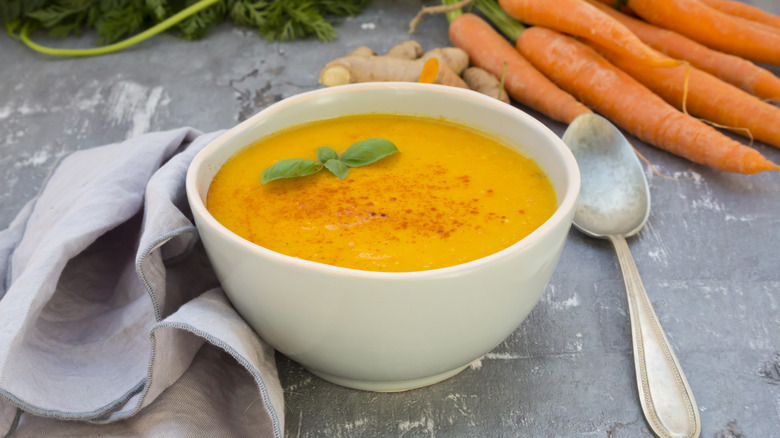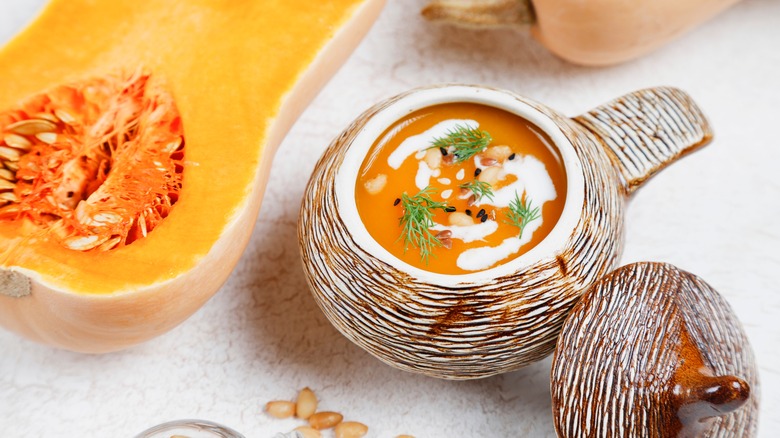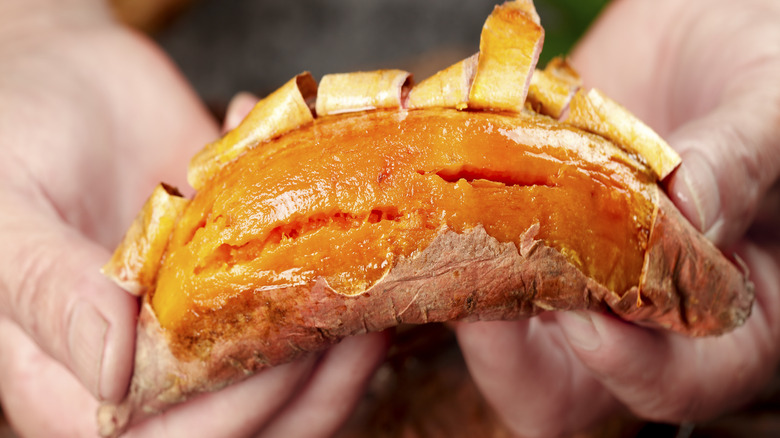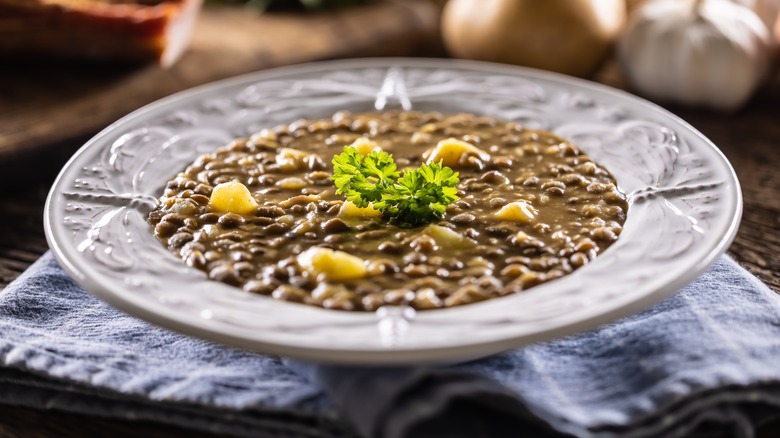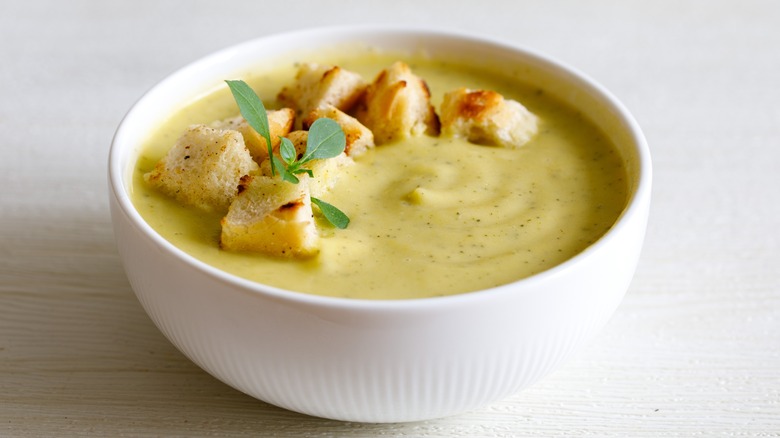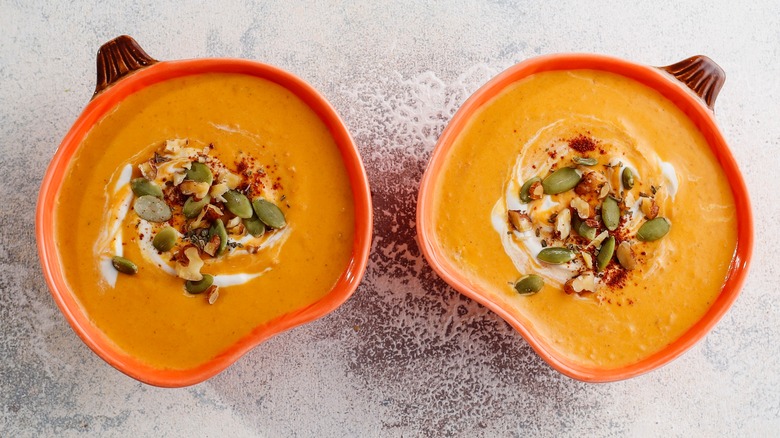The Absolute Best Substitutes For Carrots In Soup
When it comes to comforting soups, carrots are definitely recurring cast members, so much so that we can take them for granted. This dependable vegetable is always right there at the back of the crisper drawer when you need it ... until it isn't. If nutty carrot and apple soup or beef and Guinness stew is on the menu, but you find that you are fresh out of this root veggie, you still have a few options to replace it.
In order to figure out the best stand-in, you need to consider what role the carrots play in your recipe. Are they there for a creamy texture, delicate sweetness, satisfying heartiness, or beautiful color? From there, you can figure out the best substitute for the job. While an obvious replacement might be another starchy, orange vegetable, that is not your only choice. In fact, some of these substitutions create such a delicious final dish, you might find yourself reaching for them instead of carrots the next time you are craving a warm bowl of soup.
Winter squash
All sorts of winter squash can come to the rescue when you do not have carrots on hand. Try butternut, honey nut, kabocha, delicata, or acorn squash. Even pumpkin will do the trick. However, even though they cook up to be tender and creamy, winter squashes are not as easy to work with, on account of their tough skins and firm flesh.
Whenever you are working with hard-to-cut produce, use your biggest, sharpest knife. The size gives you the leverage you need, and a properly sharpened tool makes all the difference. Pro tip: Use your microwave to soften whole squash before you start hacking away. Prick the fruit several times with a fork, place it in a microwave-safe dish, and then zap it for a few minutes. Large squash or pumpkins will need about 5 minutes, while smaller varieties will take less time. The knife will cut through much more easily after that!
From there, halve the squash and scoop out the seeds. The best way to roast butternut squash is in the oven with the cut side down, and the same holds true for most other winter squashes. Roasted squash can be easily scooped out of the skin and pureed for creamy, carrotless soups. You can also cut up the squash into cubes after it has been microwaved, and simmer the pieces in a soup where you would typically have whole pieces of carrot.
Sweet potatoes
Sweet potatoes are an amazing substitute for carrots when you are making a soup recipe that leans towards the sweet and creamy. These tubers are also similarly affordable and accessible, and there are a few different ways to prepare them. To roast them, wash the potatoes well, and then prick them all over with a fork. Roast the spuds whole in a 425 degrees Fahrenheit oven for about 45 minutes or so.
You can also just pop the pierced sweet potatoes in the microwave. This cooking method will only take about 5 minutes, but the flavor will not be quite as sweet and concentrated as with roasting. Once the sweet potatoes are cool enough to touch, you can easily peel off the skin.
Before you add them to your broth or stock, you can mash the sweet potatoes with a fork or puree them using a blender or food processor, depending on the texture you are after. Unlike regular potatoes, sweet potatoes do not turn gluey when blended at high speeds. If there are other ingredients that need to be pureed in the soup — such as aromatics, herbs, or cream — just dump the cooked sweet potato right into the pot, and use an immersion blender to bring everything together.
White or yellow potatoes
While potatoes do not have the characteristic sweetness of carrots, they certainly have a similar texture that works well in soups. For a sweet, pureed recipe, a potato is not your guy, but for something like beef barley, chicken and vegetable, lentil, and split pea soups, they can definitely stand in. Use potatoes as a substitute when the carrots are cooked in the broth and meant to maintain their integrity, not when they are cut small and sauteed at the beginning to build a flavorful base.
Cut the potatoes to whatever shape and size the recipe calls for, and then just let them simmer away. In general, carrots cook more quickly than potatoes do, so you should allow for a few more minutes of boiling time. Potatoes can stay toothsome or become soft and tender just like carrots, so they are a great stand-in for hearty stews. You can actually treat other root vegetables, like parsnips or turnips, in the same way, though the flavors are a bit more earthy and bitter when compared to potatoes or carrots.
Summer squash
This substitution takes a little imagination, but trust us, it totally works. Summer squash varieties — such as zucchini, patty pan, and yellow squash — can be transformed into a velvety soup when blended, just like carrots.
To really concentrate the natural sweetness of the squash, cut it into chunks, and roast in the oven along with the seasonings you would usually find in a carrot soup, like curry powder, ginger, or rosemary. Or, just sautee the squash in with the other aromatics right in the pot. Keep in mind that summer squash does cook faster than carrots do. Once tender, blend the veggies up with a brothy base, and finish with some heavy cream, full-fat yogurt, or crème fraîche for added richness. Now, it comes as no surprise that the color and vibe of a soup made with summer squash will be quite different, but it will still be silky, creamy, and subtly sweet.
Canned pumpkin
That trusty can of pumpkin puree in your pantry can come in handy yet again. Smooth, sweet, and of course, beautifully orange, this product does a surprisingly good job as a carrot substitute in blended soups. If you have any frozen canned pumpkin stashed away, this is also a great way to give it new life. The downside to canned pumpkin is that it can taste a little flat and watery. It definitely does not have the same vibrancy as a fresh vegetable, but with the right seasonings and preparation, it can still shine.
First, make sure you are building a flavorful base with aromatics like onions and garlic. Once those veggies are softened, you add the puree. You want to spend a few minutes caramelizing the pumpkin, cooking out excess water and the concentrating flavors, like you might with tomato paste. Add plenty of spices and herbs, pour in chicken or vegetable broth, and allow everything to simmer together so the flavors can meld.
Pumpkin can pair well with all kinds of interesting flavor combinations. Start with ginger, shallots, and fresh chilies for the base, and finish the soup with rich coconut milk, Thai basil, and toasted peanuts. Or, go with classic autumnal flavors like thyme and sage, and garnish with some honey roasted pepitas. While canned pumpkin puree cannot lend that toothsome texture that fresh carrots have, it definitely makes for a delicious creamy soup.

